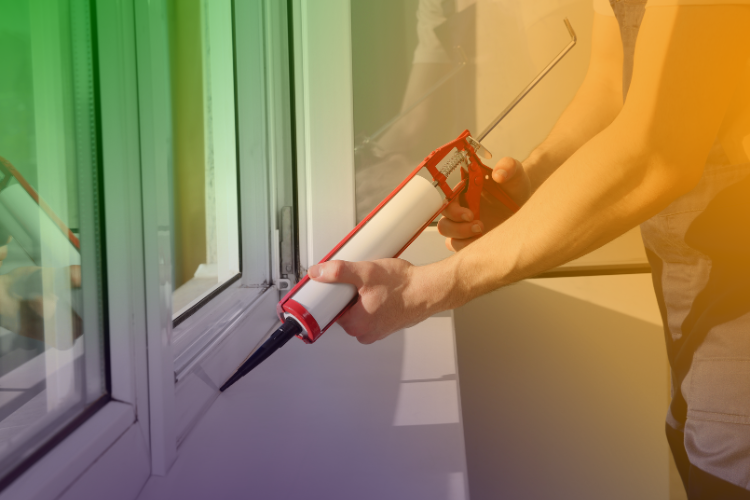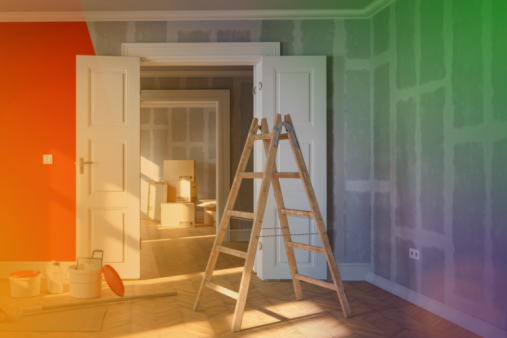To repair a window seal, follow these steps:
-
Clean the area: Use a cloth to wipe the area around the window seal to remove any dirt, dust or debris. You want the area to be clean before you begin repairing.
-
Inspect the seal: Look for any cracks or damage to the seal. If you see any, use a razor blade or utility knife to carefully remove the damaged section.
-
Apply sealant: Apply a clear, waterproof sealant to the area where the seal was damaged. Use a caulking gun to apply the sealant in a smooth, even line.
-
Smooth the sealant: Use a plastic spoon or a tool specifically designed for smoothing sealant to spread and smooth out the sealant. Make sure the sealant fills the gap evenly and completely.
-
Allow the sealant to dry: Check the manufacturer's instructions for the recommended drying time. This can vary depending on the type of sealant used. Be patient and allow the sealant to fully dry before using the window.
By following these steps, you can repair a window seal and prevent any drafts or leaks from entering your home. If you are not comfortable repairing the seal yourself, consider contacting a professional to do the job.
How to reseal double glazed windows
To reseal double glazed windows, follow these steps:
-
Inspect the window: Look for any gaps or cracks in the existing sealant around the window. This can be done by visually inspecting the window, feeling for drafts or listening for whistling noises when the wind blows.
-
Remove the old sealant: Use a putty knife or scraper to carefully remove any old sealant around the edges of the window. Be careful not to damage the glass or frame.
-
Clean the area: Wipe the area around the window with a clean, dry cloth to remove any dust, dirt or debris. You want the area to be clean and dry before applying new sealant.
-
Apply new sealant: Use a high-quality silicone sealant that is designed for windows. Apply the sealant in a continuous, even line around the edges of the window. Make sure the sealant fills the gap evenly and completely.
-
Smooth the sealant: Use a plastic spoon or a tool specifically designed for smoothing sealant to spread and smooth out the sealant. Make sure the sealant is smooth and level with the surface of the window.
-
Allow the sealant to dry: Check the manufacturer's instructions for the recommended drying time. This can vary depending on the type of sealant used. Be patient and allow the sealant to fully dry before using the window.
By following these steps, you can reseal double glazed windows and prevent any drafts or leaks from entering your home. It is important to maintain the sealant around your windows to ensure their energy efficiency and longevity.
How to fix condensation between window panes
Condensation between window panes is usually caused by a failure of the seal between the panes, allowing moisture to enter. The seal can fail due to a variety of factors, including:
-
Age: Over time, the sealant material used to seal the window panes can deteriorate and lose its effectiveness, allowing moisture to seep in.
-
Extreme temperatures: Extreme temperatures, such as very hot or very cold weather, can cause the seal to expand and contract, eventually leading to failure.
-
Exposure to sunlight: Sunlight can cause the seal to degrade and break down over time.
-
Physical damage: Physical damage to the window, such as cracks or breaks, can also cause the seal to fail.
-
Poor installation: If the window was not installed correctly, or if the seal was not applied properly, it may fail prematurely.
When the seal fails, moisture can enter the space between the panes, which causes the condensation to appear. This can be a frustrating problem, as it can obscure the view through the window and reduce the energy efficiency of your home. It's important to address the issue promptly to prevent further damage to your windows or your home.
If you have condensation between window panes, it usually means that the seal between the panes has failed, allowing moisture to enter. Unfortunately, this type of issue is typically not repairable, and the affected window pane will likely need to be replaced. However, you can follow these steps to confirm whether the window needs to be replaced or not:
-
Clean the window: Clean the affected window thoroughly to make sure the condensation is not just on the surface of the glass. If the condensation remains after cleaning, the seal has likely failed.
-
Check for warranty: Check to see if the window is still under warranty. Some window manufacturers offer warranties that cover seal failure, so you may be able to have the window replaced at no cost to you.
-
Contact a professional: Contact a professional window company to have the window inspected and measured for replacement. They can also advise you on the best type of replacement window for your needs.
-
Replace the window: If the window cannot be repaired, the only solution is to replace the affected pane or the entire window. A professional can remove the old window and install the new one correctly.
By following these steps, you can address condensation between window panes and restore the energy efficiency of your windows. It's important to act quickly if you notice condensation between your window panes, as this issue can lead to other problems, such as mold or rot, if left unaddressed.
How to repair cracked window putty
To repair cracked window putty, follow these steps:
-
Remove the old putty: Use a putty knife to carefully remove any old or damaged putty from the window frame. Be careful not to damage the glass.
-
Clean the area: Wipe the area around the window with a clean, dry cloth to remove any dust, dirt or debris. You want the area to be clean and dry before applying new putty.
-
Apply new putty: Take a small amount of window putty and roll it between your hands to create a long, thin rope. Press the putty rope into the gap between the glass and the window frame, making sure it fills the gap completely. Use a putty knife to smooth out the putty and create a neat, even finish.
-
Allow the putty to dry: Check the manufacturer's instructions for the recommended drying time. This can vary depending on the type of putty used. Be patient and allow the putty to fully dry before painting the window.
-
Paint the window: Once the putty is dry, you can paint the window frame to match the rest of the window. Use a high-quality paint that is suitable for exterior use.
By following these steps, you can repair cracked window putty and restore the appearance and functionality of your windows. It's important to maintain the putty around your windows to ensure their longevity and energy efficiency. If you're not comfortable doing the repairs yourself, consider contacting a professional to help you.
How much does it cost to reseal windows?
The cost of resealing windows in the UK can vary depending on several factors, such as the number of windows, the size of the windows, and the type of sealant used. On average, the cost of resealing a single standard-sized window can range from £50 to £150.
However, if the windows require more extensive repairs or replacements, the cost can increase significantly. For example, if the window frames are damaged and need to be replaced, or if the double-glazed units need to be swapped out, the cost can range from £250 to £500 per window.
It's important to get quotes from several different window repair companies to compare prices and ensure you're getting a fair price. Additionally, you should also consider the experience and reputation of the company, as well as any warranties or guarantees they offer for their work.
FAQs
Can seals on double glazed windows be repaired?
In most cases, the seals on double glazed windows cannot be repaired. Once the seal has failed, it usually means that moisture has entered the space between the window panes, and this cannot be removed without replacing the window.
However, some companies offer a service where they can remove the failed double glazed unit and replace it with a new one, while leaving the existing frame intact. This is often more cost-effective than replacing the entire window.
It's important to address failed seals on double glazed windows promptly to prevent further damage to your windows or your home. If you notice condensation or fogging between your window panes, it's best to contact a professional window company to have the window inspected and measured for replacement. They can advise you on the best course of action for your particular situation.
Can you reseal a window yourself?
Yes, you can reseal windows yourself if you have some DIY experience and the right tools. However, it's important to note that resealing windows can be a tricky and time-consuming process, and it's important to follow the correct procedures to ensure a proper seal and avoid any further damage to the windows.
To reseal a window, you will need some basic tools such as a putty knife, a scraper, a cleaning solution, and a sealant. You may also need a heat gun or a hairdryer to soften the old sealant, depending on the type of window and the sealant used.
The steps for resealing a window are:
-
Remove the old sealant using a scraper or putty knife, being careful not to damage the window frame or glass.
-
Clean the window frame and glass thoroughly using a cleaning solution, removing any dust, dirt, or debris.
-
Apply a new bead of sealant around the perimeter of the window frame, using a caulking gun or a manual applicator.
-
Smooth the sealant with a putty knife or your finger, making sure it covers the gap between the frame and the glass evenly.
-
Allow the sealant to dry and cure according to the manufacturer's instructions.
It's important to choose the right type of sealant for your window, as different sealants have different properties and are suitable for different types of windows. If you're not confident in your DIY skills or don't have the necessary tools, it may be best to contact a professional window repair company to reseal your windows for you.
Can a broken window seal cause damp?
Yes, a broken window seal can cause damp inside a building. When the seal on a double-glazed window fails, it allows moisture to enter the space between the glass panes, leading to condensation and water buildup. This moisture can cause damage to the window frame and surrounding walls, and can also create an ideal environment for mold growth.
If left unaddressed, the moisture from a broken window seal can lead to dampness and mold growth, which can be harmful to the health of occupants and can also cause structural damage to the building. It's important to address a broken window seal promptly to prevent further damage to your windows or your home. A professional window company can inspect the window and advise you on the best course of action, which may involve replacing the window or the double-glazed unit.








